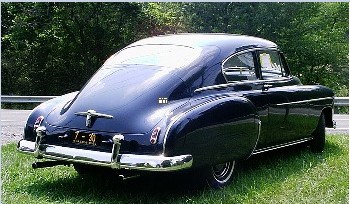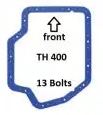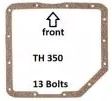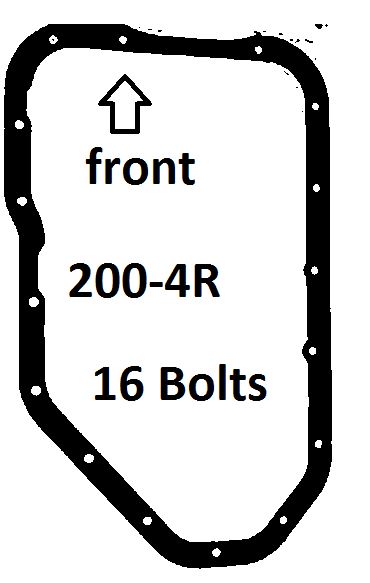Common GM Transmissions

| Transmission | First Gear Ratio | Second Gear Ratio | Third Gear Ratio | Fourth Gear/Overdrive |
| 700R4/4L60 | 3.06 | 1.63 | 1.00 | 0.70 |
| 2004R | 2.74 | 1.57 | 1.00 | .67 |
| TH-350 | 2.52 | 1.52 | 1.00 | N/A |
| TH-400 | 2.48 | 1.48 | 1.00 | N/A |
| Powerglide | 1.74 | 1.00 | N/A | N/A |
Non-Computer Controlled Transmissions
Post WWII, it is easiest to put cars into groups. Group one would be the non computer controlled transmissions. These transmissions are going to rely on engine vacuum and physical cables to know what the engine is doing. As these transmissions got closer the to the computer controlled era, they certainly got a lot better.
Basically, these are the transmissions that people talk about from “the good ole’ days”.
Powerglide
The powerglide was introduced in the 1950’s and was the common Chevrolet automatic through the mid 1960’s. It was used in many iconic GM cars of the time, such as the 57 Chevy. Many Powerglides share the now common 27 spline as the Turbo 350, it must be verified as many of them have a 17 spline shaft. They still dominate the world of drag racing even today. Modern transmissions use many more gears for fuel mileage purposes. They keep the motor in the most efficient parts of its power band. The corvette used a different tail shaft.
Here is the main page on the Powerglide.
Ratios:
| Reverse | First Gear Ratio | Second Gear Ratio | Third Gear Ratio | Fourth Gear/Overdrive |
| 1.76 | 1.76/1.82(rare) | 1.00 | N/A | N/A |
Identification:

- The word “Powerglide” is written on the body of the transmission itself. This is far and away the easiest way to identify them.
- Otherwise just look and see if you have the right pan. It’s pretty rectangular and has 14 bolts.
- If you want to identify exactly where it came from, here is a pretty good write up.
- In it’s most common form it is 27″ Long with a rear mount 19.5″ from the bellhousing.
Turbo 400
The Turbo Hydra-Matic 400 was introduced in the 1964 model year. It was the first commonly used 3 speed, and like the Powerglide before it, is well know for its durability. It survived all the way through the 80’s and was renamed 3L80 when GM changed the way that they name their transmissions. It was ultimately replaced by the 4L80E.
Here is the long writeup on the TH400.
Here is a post on Th400 vs 4L80E Differences.
| Reverse | First Gear Ratio | Second Gear Ratio | Third Gear Ratio | Fourth Gear/Overdrive |
| 2.00 | 2.48 | 1.48 | 1.00 | N/A |
Identification:

- Look at the bottom of the pan. You will count 13 bolts. The only other pan that has 13 bolts is the Th-350. Compare the differences between the gaskets and you should be able to tell the difference.
- In it’s most common form it is 28″ Long with a rear mount 26.25″ from the bellhousing.
- It is visibly bigger than other GM automatics of it’s era.
- Driver’s side above the pan is where to locate the ID tag
Turbo 350
The Turbo Hydra-Matic 350 was introduced in the 1969 model year. It was introduced to replace the Powerglide in light duty cars and trucks. It survived all the way through the 80’s and was renamed 3L80 when GM changed the way that they name their transmissions. It was ultimately replaced by the 4L80E.
Here is the main writeup on the TH350, and here is the TH350 Identification article.
Here are a few write-ups comparing the TH350 to other transmissions:
| Reverse | First Gear Ratio | Second Gear Ratio | Third Gear Ratio | Fourth Gear/Overdrive |
| 1.93 | 2.52 | 1.52 | 1.00 | N/A |
Identification:

- Look at the bottom of the pan. You will count 13 bolts. The only other pan that has 13 bolts is the Th-400. Compare the differences between the gaskets and you should be able to tell the difference.
- In it’s most common form it is 27″ Long with a rear mount 19.5″ from the bellhousing.
- It is the same dimensions as the Powerglide that it replaced. This was so that vehicles in their production run could begin using it without retooling any of the assembly processes.
TH200-4R
The Turbo Hydra-Matic 2004R was introduced in the 1981 model year. It did not necessarily replace a particular transmission. It was introduced to help with the ever more stringent fuel economy and emissions standards. It is easily swapped with the TH-350, as they share similar dimensions. The 700R4 is longer than this unit.
| Reverse | First Gear Ratio | Second Gear Ratio | Third Gear Ratio | Fourth Gear/Overdrive |
| 2.07 | 2.74 | 1.57 | 1.00 | 0.67 |
Identification:
- The 200-4R has 16 bolt holes in the pan gasket
Here is the long article on the 200-4R.
700-R4
The Turbo Hydra-Matic 700R4 was introduced in the 1981 model year. It did not necessarily replace a particular transmission. It was introduced to help with the ever more stringent fuel economy and emissions standards. It is easily swapped with the TH-350, as they share similar dimensions. The 700R4 is longer than this unit. Here is a great write up on 700r4 transmission identification.
| Reverse | First Gear Ratio | Second Gear Ratio | Third Gear Ratio | Fourth Gear/Overdrive |
| 2.29 | 3.06 | 1.62 | 1.00 | 0.70 |
Here is the long article on the 700-R4.
Modern GM Automatic Transmissions
By modern, really that means anything computer controlled. There was certainly some overlap in the early nineties for sure. In fact, the TH400 still finds use in some military applications. Computer controlled transmissions ushered in a new era of diagnosis, shift tables and reliability.
Shift tables allowed transmissions to adapt shifting to different conditions and wear. They also made tow/haul mode a thing. This is only possible through computer control. There is one one shift table for the truck when it has no load, and another one for when it does. Think about that. It allows it to be better at both towing and economy.
4L60E
The 4L60E is the successor to the 700R4. They share a similar case and mechanical attributes. The 4L60E came about as General Motors got into more complex computer controlled engines.
Here is the in depth writeup on the 4L60E, and here is how you identify the 4L60E.

| Reverse | First Gear Ratio | Second Gear Ratio | Third Gear Ratio | Fourth Gear/Overdrive |
| 2.29 | 3.06 | 1.62 | 1.00 | 0.70 |
4L80E
The 4L80E was designed to replace the venerable 3L80/TH400. It added an overdrive gear and allowed the ECU to control the shifts, whereas its predecessor did not allow for this. This was the go to heavy duty transmission for GM until the 6L80E replaced it.
Here is the writeup on 4L80E Problems, and here is the writeup on 4L80E Identification.
Also, if you are thinking about an LS swap, here’s some information on benefits of a 4L60E vs 4L80E.
Here is a post on Th400 vs 4L80E Differences.
| Reverse | First Gear Ratio | Second Gear Ratio | Third Gear Ratio | Fourth Gear/Overdrive |
| 2.08 | 2.48 | 1.48 | 1.00 | 0.75 |
6L80E
The 6L80E was engineered to help GM meet the CAFE fuel economy standards on their thirsty V8 cars and trucks. It replaces the 4L60E and 4L80E beginning in the 2006 Model year. Here’s more on the 6L80E.
4T65E
The 4T65E has been around for around 20 years and was phased out around 2011. It’s a very reliable transmission with many varying ratios. Here’s what we have on it.
8L90E
The 8L90 is used in performance car applications and pickup trucks. It has eight forward gears and a highly advanced TCM that allows for supercar quality shifts. It’s been in production since the 2015 model year.



